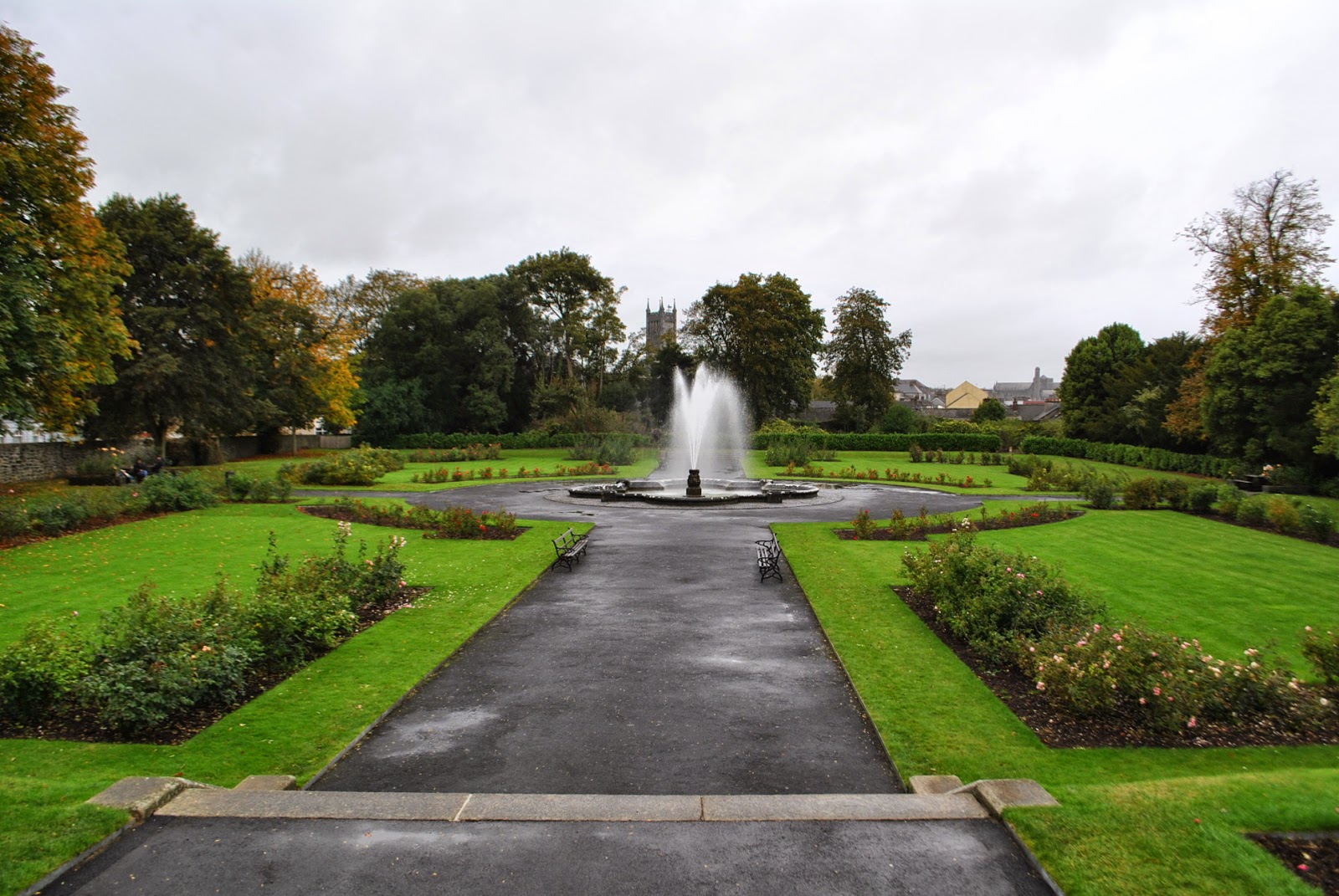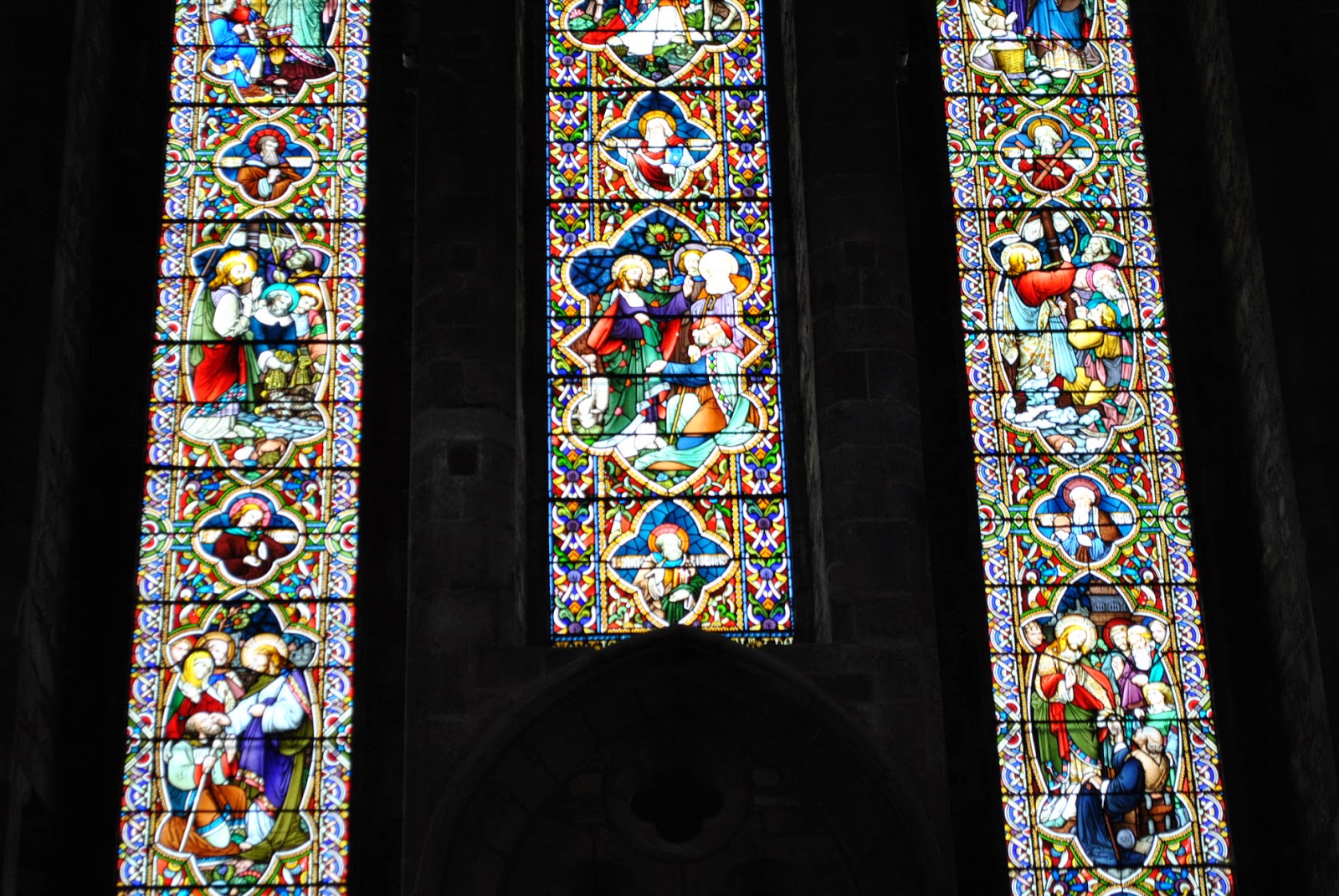This week, Sister Mary took us to Kilkenny. Kilkenny is full of history, as it has a castle that is over 800 years old, a tower and cathedral that is over 1,000 years old, and another cathedral built during The Great Famine in Ireland. Many wars have taken place there, and the river that runs through Kilkenny carries an abundance of salmon.
Our first stop was to Kilkenny Castle. The castle was owned by royalty, and sold to the Butler family a couple hundred years later. The Butler family plays a huge part of Kilkenny's history. They were a wealthy family with ties to the royal family in England. In fact, Anne Berlin, Queen Elizabeth's mother was of the Butler family.
The Butler's owned the castle for over 600 years, and remodeled it several times. Royalty was tied into the Butler family, so it was well known that members of the royal family would stay at the castle regularly. This brought wealth to the city back in the day, and so Kilkenny thrived. The castle was exquisite, but unfortunately, we were not allowed to take photographs, so I don't have any of inside the castle. Outside, however, they had acres and acres of land, a fountain, and a beautiful rose garden.
The Butlers sold the house in the 1970's, and it was abandoned for a long time, until the county purchased it, and the items sold at auction to remodel the house like it once was. They uncovered original wallpaper, and made replicas of all of their belongings. There are some original pieces as well. It was really cool to see how they fixed up the castle to make it how it once was.















The second place we visited Saint Canice's Cathedral, which is over 1,000 years old, and took over 83 years to build. It was beautiful from the inside and outside. The cathedral also has a tower built by the monks that is over 7 stories high. We got to climb the tower, which took about 10 minutes, and might I say it was horrifying to someone with vertigo, but I did it. The view from the top was pretty, but I only stayed up there for less than 3 minutes because I felt like I was going to have a heart attack looking down. While climbing the tower, the steps are going straight up, so you are climbing 7 ladders, pulling yourself up with your arms. It was hard, but amazing. The fact that it was built by monks on their own amazed me.
Inside the cathedral, there were a lot of tombs, and stained glass. The construction of the church was fantastic and had several different types of architecture. The Butler family, who owned Kilkenny Castle was also buried there. The tombs were massive, and made of stone, which was carved. The floors were polished marble, a specialty of Kilkenny. This cathedral also holds the oldest bishop's seat in Ireland. It was stunning and almost haunting being in the church.
From inside and on top the tower:
Then we made our way to Saint Mary's Cathedral, which was built during The Great Famine in Ireland by the Butler family to gain more employment for the people of Kilkenny. It was a very dark cathedral, and it represents the trials and tribulations of the time in Ireland.
Then we made our way over to the Smithwick's brewary, where we got to learn about how their beer is made and processed, with a complimentary pint or half pint at the end.
We ended our very long day with a bit of roaming the city for some shopping, then off to a a very cool restaurant once owned by the famous Dame Alice Kyteler.The pub was established back in 1324, and we were sat in the basement, which was decorated for Halloween, and was spooky. They had great food, and I had a great time. Alice's story is very interesting, this is from the pub's website:
"On a day in 1280, Alice de Kyteler was born in Kyteler’s House, Kilkenny to wealthy Norman parents.
Forty four years later, in 1324, she fled to England to escape being
burned as a witch and in July of that year, her property, including
Kytelers Inn was confiscated.
In the intervening years Dame Alice had married four times, has been
Mistress of Kytelers Inn and had become a central figure in a battle
between the Church and the Temporal Power in Ireland.
He first husband was William Outlawe, a local banker and they had a
son, also called William, who was to feature strongly in the saga of her
life. Her husband took ill and died suddenly within a few years of
marriage and shortly afterwards Alice married her second wealthy
husband, Adam de Blund of Cullen who soon also died suddenly and
mysteriously. Having inherited two substantial fortunes, the now very
wealthy Alice married Richard de Valle and the pattern continued with
his early, sudden and mysterious death.
It was the fourth husband of Kilkenny’s ‘Merry Widow’ however who
unwittingly began a chain of events that would lead to Alice being
convicted on charges on witchcraft before an ecclesiastical court. Some
years after his marriage to Alice, landowner Sir. John de Poer showed
signs of illness. His hair and nails fell out and he became weak and
sickly. Shortly before he succumbed to death, he changed his Will to the
benefit of Alice and her son William, an act which resulted in anger
and resentment among his other family members. Armed with rumours (which
may have been false and inspired by local jealousy), they brought
charges of witchcraft and sorcery against Alice before the English-born
Franciscan Bishop of Ossory, Richard de Lederer. They claimed that Alice
had ‘bewitched’ her husband and forced him to change his Will. His
Lordship convened a Court of Inquisition which included five Knights and
several Noblemen which heard evidence that Alice headed a coven of
witches and had sex with a demon called Artissen, who is sometimes
depicted as Aethiops, the mythical founder of Ethiopia.
What followed next was a legal and political battle in which Bishop
Lederer tried, but failed, to get the Temporal Authority to arrest and
condemn Alice, her son William Outlawe and several of her friends and
servants. The Bishop was himself arrested and imprisoned in Kilkenny
jail, but on his release he continued his campaign, demanding that Alice
appear before him. She wisely refused and promptly left for England,
returning a year later to Dublin where she urged the Archbishop to
condemn the Bishop of Ossory for unlawfully excommunicating her. A
showdown between the Commissioner and Bishop Lederer took place in
Dublin and ended with the Bishop returning to Kilkenny from where he
demanded that Alice be arrested. She heard about the request and
promptly returned to England.
The Kilkenny Witchcraft Trials did however take place. William
Outlawe was convicted and ordered by Bishop Lederer to attend three
Masses every day and to give alms to the poor. This light sentence was
in sharp contrast to the torture meted out to less wealthy friends of
Alice, including her maid Petronella who was tortured, whipped and
finally burned at the stake.
Alice disappeared from history following her second escape to
England, but her memory lives on in folklore. In 2004, Paddy Shaw, an
American artist, painted a portrait of Alice de Kyteler, based on his
knowledge of her life and his imagination. She is coupled in the
painting with a representation of the demon Aethiops. Some years later,
in 2005, Kilkenny writer Claire Nolan completed a novel called ‘The
Stone’, which is a fictional account of the life of Dame Alice. The
painting lay in Paddy Shaw’s studio until one day it turned up in the
post at Kytelers Inn with a note from the artist saying ‘Alice doesn’t
like being with me- you have her’."
Pictures of us out and about Kilkenny:
This was a really fun trip, but I wish we had more time to see stuff. Hopefully I'll be able to return to Kilkenny before I leave Ireland.








































































